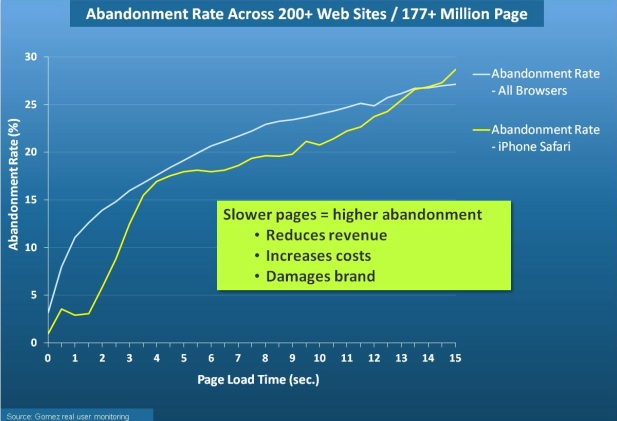(Editor’s note: Matthew Poepsel is vice president of Performance Strategies at Compuware. He submitted this story to VentureBeat.)
As smart phones become a regular part of more people’s lives, the speed at which websites load and other data is transmitted is becoming more and more important.
Historically, the consensus has been that most people expect slower website, app or video streaming performance on mobile devices – regardless of the carrier. The inconvenience, it was said, was offset by the novelty of the “anywhere web”. However, our research paints a very different picture, specifically that the “…well, it’s just wireless!” rationale is quickly losing ground.
Gomez benchmarks reveal a 9-second difference in response time from the leading mobile website to the site ranked 15th, even for the same device on the same wireless carrier. This means that even on the same network, some websites have found a way to offer stellar speeds while others are making users play the waiting game.
AI Weekly
The must-read newsletter for AI and Big Data industry written by Khari Johnson, Kyle Wiggers, and Seth Colaner.
Included with VentureBeat Insider and VentureBeat VIP memberships.
Another common (mis)perception is that visitors, accustomed to slower load times on mobile carriers, will wait longer for a web page to load on their wireless service. That’s not the case.
We monitored actual end-users and compared their mobile vs. other browsing habits. What we found was revealing (see chart below): after 3 seconds of wait time, abandonment rates for mobile devices are quite similar to those of desktop browsing. So mobile users on wireless carriers will cut you a tiny bit of slack before bolting, but not much.

Clearly, consumers are getting more impatient and many web businesses are simply not meeting their expectations. The Compuware Gomez Retail Satisfaction Index for the 2010 holiday shopping season showed an aggregate mobile score of 47.3, which is considered only “tolerable” performance in comparison to a 84.2 score for desktop websites.
So if speed isn’t just about the wireless network, why are some websites so slow when others are near-desktop fast? Simply put, high-performing companies understand the “need for speed” better than their pokey counterparts. Speed demons proactively optimize and tune their websites accordingly. Here are some best practices for mobile site owners who want to speed things up:
Benchmark against the performance leaders in your industry. The response time leaders in your category set the standard against which your customers will evaluate your site. By basing your performance levels on the leaders, you’ll always keep pace.
Optimize your mobile site for speed. Most mobile users consider speed more important than features. So streamline web content for your mobile site by dropping unwanted features and unnecessarily “heavy” content like graphics and other images.
Measure website speed from the end-user and under various loads. This practice separates the hares from the tortoises. Taking the end-user view helps verify that all elements of a web application (including those delivered from third-parties) can effectively scale. Just because your datacenter’s dashboard shows green lights, it doesn’t mean your wireless visitors are having a good experience.
Mobile device capabilities have exploded in the last two years, but unfortunately mobile device performance hasn’t kept pace. Speed-wise, wireless mobile is somewhat reminiscent of where the fixed web was ten years ago.
As the novelty of the “anywhere web” wears off, users will want mobile websites that perform. Businesses that embrace mobile performance — whether they are startups or established companies — will grow site traffic, improve sales conversions and enhance their brands.
VentureBeat's mission is to be a digital town square for technical decision-makers to gain knowledge about transformative enterprise technology and transact. Learn More